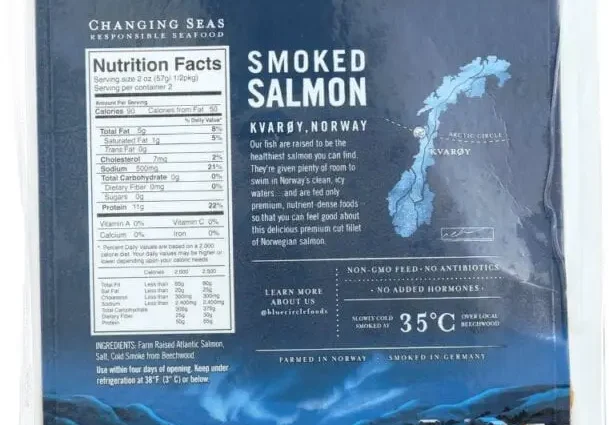Nutritional value and chemical composition.
| Nutrient | Quantity | Norm** | % of the norm in 100 g | % of the norm in 100 kcal | 100% normal |
| Calorie value | 199 kCal | 1684 kCal | 11.8% | 5.9% | 846 g |
| Proteins | 26.4 g | 76 g | 34.7% | 17.4% | 288 g |
| Fats | 10.4 g | 56 g | 18.6% | 9.3% | 538 g |
| Water | 53.5 g | 2273 g | 2.4% | 1.2% | 4249 g |
| Ash | 9.7 g | ~ | |||
| Vitamins | |||||
| Vitamin A, RE | 20 μg | 900 μg | 2.2% | 1.1% | 4500 g |
| Vitamin B1, thiamine | 0.05 mg | 1.5 mg | 3.3% | 1.7% | 3000 g |
| Vitamin B2, riboflavin | 0.12 mg | 1.8 mg | 6.7% | 3.4% | 1500 g |
| Vitamin E, alpha tocopherol, TE | 1 mg | 15 mg | 6.7% | 3.4% | 1500 g |
| Vitamin PP, NE | 5.7 mg | 20 mg | 28.5% | 14.3% | 351 g |
| Macronutrients | |||||
| Potassium, K | 193 mg | 2500 mg | 7.7% | 3.9% | 1295 g |
| Calcium, Ca | 64 mg | 1000 mg | 6.4% | 3.2% | 1563 g |
| Magnesium, Mg | 26 mg | 400 mg | 6.5% | 3.3% | 1538 g |
| Sodium, Na | 3174 mg | 1300 mg | 244.2% | 122.7% | 41 g |
| Sulfur, S | 175 mg | 1000 mg | 17.5% | 8.8% | 571 g |
| Phosphorus, P | 211 mg | 800 mg | 26.4% | 13.3% | 379 g |
| Chlorine, Cl | 4895 mg | 2300 mg | 212.8% | 106.9% | 47 g |
| Trace Elements | |||||
| Iron, Fe | 1.2 mg | 18 mg | 6.7% | 3.4% | 1500 g |
| Iodine, I | 60 μg | 150 μg | 40% | 20.1% | 250 g |
| Cobalt, Co | 30 μg | 10 μg | 300% | 150.8% | 33 g |
| Manganese, Mn | 0.1 mg | 2 mg | 5% | 2.5% | 2000 g |
| Copper, Cu | 120 μg | 1000 μg | 12% | 6% | 833 g |
The energy value is 199 kcal.
- Vitamin PP participates in redox reactions of energy metabolism. Insufficient vitamin intake is accompanied by disruption of the normal state of the skin, gastrointestinal tract and nervous system.
- Phosphorus takes part in many physiological processes, including energy metabolism, regulates acid-base balance, is a part of phospholipids, nucleotides and nucleic acids, is necessary for the mineralization of bones and teeth. Deficiency leads to anorexia, anemia, rickets.
- Chlorine necessary for the formation and secretion of hydrochloric acid in the body.
- Iodine participates in the functioning of the thyroid gland, providing the formation of hormones (thyroxine and triiodothyronine). It is necessary for the growth and differentiation of cells of all tissues of the human body, mitochondrial respiration, regulation of transmembrane sodium and hormone transport. Insufficient intake leads to endemic goiter with hypothyroidism and a slowdown in metabolism, arterial hypotension, growth retardation and mental development in children.
- Cobalt is part of vitamin B12. Activates enzymes of fatty acid metabolism and folic acid metabolism.
- Copper is a part of enzymes with redox activity and involved in iron metabolism, stimulates the absorption of proteins and carbohydrates. Participates in the processes of providing the tissues of the human body with oxygen. The deficiency is manifested by disorders in the formation of the cardiovascular system and skeleton, the development of connective tissue dysplasia.
Energy value, or calorie content Is the amount of energy released in the human body from food during digestion. The energy value of a product is measured in kilo-calories (kcal) or kilo-joules (kJ) per 100 grams. product. The kilocalorie used to measure the energy value of food is also called the “food calorie,” so the kilo prefix is often omitted when specifying calories in (kilo) calories. You can see detailed energy tables for Russian products.
The nutritional value – the content of carbohydrates, fats and proteins in the product.
Nutritional value of a food product – a set of properties of a food product, in the presence of which the physiological needs of a person for the necessary substances and energy are satisfied.
Vitamins, organic substances required in small quantities in the diet of both humans and most vertebrates. Vitamins are usually synthesized by plants rather than animals. The daily human need for vitamins is only a few milligrams or micrograms. Unlike inorganic substances, vitamins are destroyed by strong heating. Many vitamins are unstable and “lost” during cooking or food processing.










